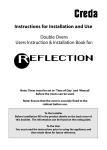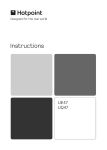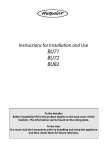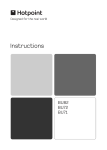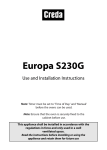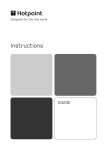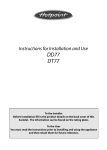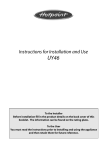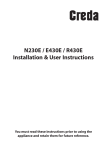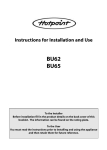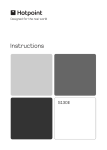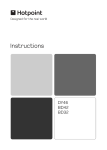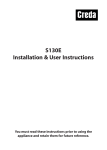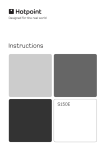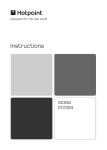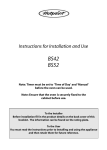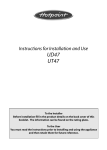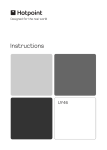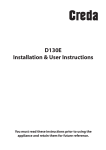Download Indesit FDE20 Oven User Manual
Transcript
Electric built in Double Oven Instructions for installation and use FDE20 Contents Introduction 4 Safety Information 5 Features 7 Controls 8 Oven Timer Operation 9 Grill Pan and Handle 15 Operation when using Top Oven for Grilling 16 Conventional Grilling 17 Using the Top Oven as a Convection Oven 18 Operation when using the Top Oven as a Convection Oven 19 Using the Main Oven for Fan Cooking 20 Using the Main Oven for Other Functions 21 Temperature Conversion Chart 23 Oven Temperature Charts 24 Cooking Results Not Satisfactory? 26 Care and Cleaning 27 Installation 31 Something Wrong? 35 If It Still Won’t Work 39 Key Contacts Back Cover You must read these instructions prior to using your appliance and retain them for future use. 3 Introduction Your new appliance is guaranteed* and will give lasting service. This guarantee is only applicable if the appliance has been installed in accordance with the installation instructions detailed in this booklet. To help make best use of your cooking equipment, please read this booklet carefully. The cooker is designed specifically for domestic use and responsibility will not be accepted for use in any other installation. When the cooker is first used an odour may be emitted, this will cease after a period of use When first using the cooker ensure that the room is well ventilated (e.g. open a window or use an extractor fan) and that persons who may be sensitive to the odour avoid any fumes. It is suggested that any pets be removed from the room until the smell has ceased. This odour is due to temporary finish on oven liners and elements and also any moisture absorbed by the insulation. * The guarantee is subject to the provisions that the appliance: (a) (b) (c) (d) 4 Has been used solely in accordance with the Users Instruction Book. Has been properly connected to a suitable supply voltage as stated on the rating plate attached to this equipment. Has not been subjected to misuse or accident or been modified or repaired by any person other than the authorised employee or agent. Has been correctly installed. Safety Information When used properly your appliance is completely safe but as with any electrical product there are certain precautions that must be observed. PLEASE READ THE PRECAUTIONS BELOW BEFORE USING YOUR APPLIANCE. Always ● Always make sure you remove all packaging and literature from inside the oven and grill compartments before switching on for the first time. ● Always make sure you understand the controls prior to using the appliance. ● Always keep children away from the appliance when in use as the surfaces will get extremely hot during and after cooking. ● Always make sure all controls are turned off when you have finished cooking and when not in use. ● Always stand back when opening an oven door to allow any build up of steam or heat to disperse. ● Always use dry, good quality oven gloves when removing items from the oven/grill. ● Always take care to avoid heat/steam burns when operating the controls. ● Always turn off the electricity supply at the wall switch before cleaning and allow the appliance to cool. ● Always make sure the shelves are in the correct position before switching on the oven. ● Always keep the oven and grill doors closed when the appliance is not in use. ● Always take care when removing utensils from the top oven when the main oven is in use as the contents may be hot. ● Always keep the appliance clean as a build up of grease or fat from cooking can cause a fire. ● Always follow the basic principles of food handling and hygiene to prevent the possibility of bacterial growth. ● Always keep ventilation slots clear of obstructions. ● Always refer servicing to a qualified appliance service engineer. ● During use the oven becomes hot. Care should be taken to avoid touching heating elements inside the oven, SAFETY ADVICE IN THE EVENT OF A CHIP PAN OR ANY OTHER PAN FIRE: 1. TURN OFF THE COOKER APPLIANCE AT THE WALL SWITCH. 2. COVER THE PAN WITH A FIRE BLANKET OR DAMP CLOTH, this will smother the flames and extinguish the fire. 3. LEAVE THE PAN TO COOL FOR AT LEAST 60 MINUTES BEFORE MOVING IT. Injuries are often caused by picking up a hot pan and rushing outside with it. NEVER USE A FIRE EXTINGUISHER TO PUT OUT A PAN FIRE as the force of the extinguisher is likely to tip the pan over. Never use water to extinguish oil or fat fires. 5 Safety Information Never ● Never leave children unsupervised where a cooking appliance is installed as all cooking surfaces will be hot during and after use. ● Never allow anyone to sit or stand on any part of the appliance. ● Never store items above the appliance that children may attempt to reach. ● Never remove the oven shelves whilst the oven is hot. ● Never heat up unopened food containers as pressure can build up causing the container to burst. ● Never store chemicals, food stuffs or pressurised containers in or on the appliance, or in cabinets immediately above or next to the appliance. ● Never operate the grill with the door closed as this will cause the appliance to overheat. ● Never use the appliance as a room heater. ● Never use the grill to warm plates. ● Never dry any items on the oven doors. ● Never install the appliance next to curtains or other soft furnishings. ● Never allow children to play with the appliance controls. ● Never use ‘steam cleaners’. 6 Features MAIN OVEN TOP OVEN TEMPERATURE TEMPERATURE & GRILL SELECTION & FUNCTION CONTROL CONTROL TOP OVEN PILOT LIGHT CLOCK & OVEN TIMER MAIN OVEN PILOT LIGHT GRILL SETTING CONTROL GRILL ELEMENT CATALYTIC SIDE LINERS GRILL PAN INNER DOOR GLASS TOP OVEN DOOR OVEN LIGHT CATALYTIC SIDE LINERS OVEN SHELF OVEN FAN MEAT PAN MAIN OVEN DOOR INNER DOOR GLASS RATING PLATE 7 Controls A GRILL SETTING CONTROL C MAIN OVEN TEMPERATURE AND FUNCTION CONTROL B TOP OVEN TEMPERATURE AND GRILL SELECTION CONTROL TIMER Control Markings Control Knob A B Description Grill Setting Control Top Oven Temperature & Grill Selection Control Function Selects the heat at which the grill will cook the food. 1 – max Grill Settings Control: 1 = Low, max = High Note: To grill you must first select a grill function using control (B). Selects the cooking temperature 100 (Degrees Centigrade) when using the top 220 oven as a conventional oven. Switches the top oven to “Half Grill” mode. C Switches the top oven to “Full Grill” mode. Fan Only Setting - This is used to decrease the amount of time required to defrost food items. Main Oven Temperature & Function Control Oven Light Only - Switches on the Main Oven Interior Light Only. 90 230 Main Oven Temperature Scale (In Degrees Centigrade). - When cooking select the required cooking temperature. Cooling Fan: A gentle flow of air will be blown below the control panel when any selector switch is used. Note: Whenever the appliance has been used, the cooling fan may run on or restart itself after all the controls have been turned off. This indicates that the appliance is still warm. Oven Interior Lights The oven lights are operated when their respective oven control is used. (N.B. Not all models have a top oven interior light). The main oven has a light only position. Slow Cooking The main oven has a “Slow Cook Setting”, 90˚C, this can be used for slow cooking, keeping food warm and warming plates for a short period. Note: It is advisable to check that all oven controls have been switched off when you have finished using the appliance. 8 Oven Timer Operation The oven timer offers you the following features: 1. 2. 3. Time of Day Automatic Cooking Minute Minder Automatic Cooking The Main Oven (only) can be controlled by the automatic timer. Never operate the grill or top oven when the main oven is set to cook automatically because the oven cavity can become warm and this may cause bacterial growth in food. Hints on Automatic Cooking 1. Select foods which will take the same time to cook and require approximately the same temperature. 2. Set the oven timer so that the food has just finished or about to finish cooking on your return to the oven. This will ensure the food has not cooled down and does not require reheating before serving. 3. Food should be as cold as possible when it goes into the oven, ideally straight from the refrigerator. Frozen meat and poultry should be thawed thoroughly before it is put in the oven. 4. We advise that warm food should never be placed in the oven if there is to be a delay period. Stews prepared by frying the meat and vegetables should be cooked as soon as possible. 5. We advise dishes containing left-over cooked poultry or meat, for example Shepherds Pie, should not be cooked automatically if there is to be a delay period. 6. Stews and joints should be cooked by the long slow method, so that the delay period is kept to a minimum. 7. On warm days, to prevent harmful bacterial growth in certain foods (ie poultry, joints, etc) the delayed start should be kept to a minimum. 8. Wine or beer may ferment and cream may curdle during the delay period, so it is best to add these ingredients just before serving. 9. Foods which discolour should be protected by coating in fat or tossing in water to which lemon juice has been added, prior to placing food in the oven. 10. Dishes containing liquid should not be filled too full to prevent boiling over. 11. Food should be well sealed (but not airtight) in a container to prevent the loss of liquid during cooking. Aluminium foil gives a good seal. 12. Ensure food is cooked thoroughly before serving. Timer Operation 1. 2. 3. Make sure all oven controls are turned Off. Check that the electricity supply to the oven is turned On. Check that the oven clock is at the right time of day. 9 Know Your Timer CLOCKFACE The timer incorporates a 24 hour clock. Ensure the correct time of day is always set, before using your cooker. SYMBOLS A ‘bell’ symbol will light up when you select a Minute Minder Period and will remain lit for the period set. At the end of the Minute Minder Period, the timer will emit an audible tone and the ‘bell’ symbol will disappear. The ‘cookpot’ symbol will light up either:– – When the timer is in manual mode, or – During the actual Cook Period. ‘AUTO’ will light up:– – When the timer is first turned on it will flash. It will go out when a time of day is set or when the timer is set to manual. The ‘AUTO’ symbol will flash at the end of an Auto Cooking programme to indicate that the programme has finished. (When the ‘AUTO’ symbol is flashing, to return the oven to Manual operation, turn the oven controls off, ensure that the correct time of day is set, and press the “Manual” button – The ‘AUTO’ symbol will go out). TIMER FUNCTION BUTTONS Minute Minder Button Here you can set a time period of up to 23 hours 59 minutes, that will count down. When it reaches zero, the timer will emit an audible tone. For Example: If you set 20 minutes, the audible tone will occur 20 minutes later. AUTO COOKING PROGRAMME Cook Period Button Cook Period is the actual length of time for which, the timer will switch the oven(s) on as part of an “Auto Cooking” programme. (e.g. If you set 2 hours, the food will be cooked for 2 hours). End Time Button The time of day at which you want an “Auto Cooking” programme to end. For Example: If you set a “Cook Period” for 2 hours, and “End Time” of 11:00. The timer will switch the oven(s) on at 9:00 and turn the oven(s) off at 11:00. You will hear a audible tone at 11:00, to indicate that the Auto Cooking Programme has finished. Notes: - When setting an Auto Cooking programme you will need to set the oven control(s) to the required temperature(s) when you set the timer. - If an Auto Cooking programme has been set the oven(s) will only operate during the pre-programmed time. Manual Button Needs to be pressed to cancel an Auto Cooking programme and return the oven(s) to Manual operation. “+” and “–” Buttons Used to adjust the various timer function settings. 10 Electronic Clock and Automatic Oven Timer Operation SETTING THE TIME OF DAY Step 1 Make sure all oven controls are turned Off. Step 2 Check the electricity supply to the cooker is turned on. Step 3 When switched on the display will show 0.00 and the Auto symbol, flashing intermittently. Step 4 Press & hold in both the Cook Period & End Time buttons together. Step 5 With the Cook Period & End Time buttons still held in, press either the “+” or “–” buttons to set the correct time of day. Step 6 Release all the buttons simultaneously. THE TIME OF DAY IS NOW SET. To change the time of day repeat Steps 4, 5 & 6 above. Note: You cannot adjust the time of day if the timer has been set for an Auto Cooking Programme. SETTING THE MINUTE MINDER Step 1 Ensure the time of day is set correctly. Step 2 Press and hold the Minute Minder button. Step 3 With the Minute Minder button held in, set the required Minute Minder period using the “+” and “–” buttons. A ‘bell’ symbol will light up. Release all buttons and the timer display will revert back to the time of day. The ‘bell’ symbol will remain lit to signify that a Minute Minder period has been set. At the end of the set time an audible tone will be heard, and the ‘bell’ symbol will disappear. Step 4 To cancel the audible tone press the Minute Minder button. Note 1 When the Minute Minder has been set, the time remaining can be checked at any time by simply pressing the Minute Minder button. Note 2 If necessary the Minute Minder can be cancelled before the tone sounds by pressing and holding the Minute Minder button and then at the same time pressing the “–” button until 0.00 appears in the display window. 11 Electronic Clock and Automatic Oven Timer Operation AUTO COOKING PROGRAMMES There are two Auto Cooking programmes that can be selected using your timer:– (a) To set the timer to switch the oven(s) On and Off Automatically (b) To set timer to switch on immediately and OFF automatically after a set cook period. a) TO SET THE TIMER TO SWITCH THE OVEN(S) ON AND OFF AUTOMATICALLY This allows you to cook at a specified time for a chosen period before the oven switches off Automatically. Step 1 Check that the correct time of day is set, if not follow instructions for setting the time of day. Step 2 Place food onto the correct shelf position in the oven and close the oven door(s). Step 3 Press and hold in the Cook Period button. The display will read 0.00 with the ‘cookpot’ symbol lit. Step 4 With the Cook Period button still held in, set the required Cook Period using the “+” and “–” buttons. Release the buttons and the timer display will revert to the time of day with the ‘Auto’ symbol and ‘cookpot’ symbol lit. Step 5 Press and hold in the End Time button. The display will read the earliest possible end time for the Cook Period that you have set above. The ‘Auto’ symbol and ‘cookpot’ symbol will be lit. Step 6 With the End Time button still held in, use the “+” and “–” buttons to set the ‘End Time’ (i.e. The time you require the oven to switch off ). Release all the buttons and the timer will revert back to the time of day. The ‘Auto’ symbol will remain lit to signify that an Auto Cooking Programme has been set. The ‘cookpot’ symbol will go out. Step 7 Turn the oven control(s) to the required temperature, and if necessary select the appropriate oven function. Note: If your appliance has two ovens: When the timer has been set for one oven it is possible to use the other oven only during the same Automatic programme. At the end of the Automatic Cook Period the Auto Symbol will flash and an intermittent bleeping sound will be heard. The audible tone will continue unless cancelled. The ‘Auto’ symbol will continue to flash until the timer is returned to Manual operation (see below). Step 8 Press the Manual button, the audible tone will be cancelled and the oven(s) will be returned to Manual. Step 9 Turn the oven control(s) to the OFF position. 12 Electronic Clock and Automatic Oven Timer Operation Note 1 When cooking automatically the Cook Period can be checked at any time by simply pressing the Cook Period button. Note 2 When cooking automatically the End Time can be checked at any time by simply pressing the End Time button. b) TO SET TIMER TO SWITCH ON IMMEDIATELY AND OFF AUTOMATICALLY AFTER A SET COOK PERIOD Step 1 Step 2 Step 3 Check that the correct time of day is set, if not follow instructions for setting the time of day. Place food onto the correct shelf position in the oven and close the oven door(s). Turn the oven control(s) to the required temperature, and if necessary select the appropriate oven function. Step 4 Press & hold in the Cook Period button, the display will read 0.00 and the ‘cookpot’ symbol will light up. With the Cook Period button still held in set the required Cook Period using the “+” and “–” buttons. Example: 1hr 30 minutes (as shown). Note: Cook Period is the length of time the food requires to cook. Step 5 Release all buttons. The timer display will revert to the time of day with the ‘Auto’ symbol lit & ‘cookpot‘ symbol remaining lit. NOTE: The Cookpot symbol disappears At the end of the Cook Period the ‘Auto’ symbol will flash and an intermittent audible tone will be heard. The audible tone will continue to flash until the timer is returned to Manual operation (see below). Step 6 Press the Manual button. The audible tone will be cancelled and the oven(s) will be returned to Manual. Step 7 Turn the oven control(s) to the OFF position. 13 Electronic Clock and Automatic Oven Timer Operation TO CANCEL AN AUTO COOKING PROGRAMME BEFORE THE COOK PERIOD HAS FINISHED. Step 1 Turn the oven control(s) to the OFF position. Step 2 Press the Manual button to return the oven(s) to “Manual” operation. The ‘Auto’ symbol will go out. Note 1 When cooking automatically the Cook Period can be checked at any time by simply pressing the Cook Period button. OTHER NOTES ON TIMER OPERATION 1. When cooking Automatically the Cook Period can be checked at any time simply by pressing the Cook Period button. 2. When cooking Automatically the End Time can be checked at any time by simply pressing the End Time button. 3. Having set a Cook Period and End Time an electronic device stores the information. The device within the timer will switch the oven(s) on and off at the required times. 4. When setting an Auto Cooking Programme and a mistake is made, to clear:– (d) Press & release the Manual button. (e) Start the sequence again. 5. If at any time the display shows three flashing zero’s 0.00 and ‘Auto’, it is likely that the electricity supply to the oven has been interrupted. Reset the timer to the correct time of day. Food in the oven may, therefore, not have been cooked, before serving check food is thoroughly heated and completely cooked. 6. To set each function always press and hold the required function button and at the same time press “+” or “–” buttons. 14 Grill Pan and Handle The grill pan handle is detachable from the pan, to facilitate cleaning and storage. The grill pan handle can be fixed as follows: (d) (a) (c) (b) Step 1 Step 2 Step 1 Step 2 Step 3 Step 4 Step 3 Step 4 Remove the screw and washers from the grill pan bracket (a). Tilt the handle over the recess (b). Slide it towards the centre of the pan (c). Locate the handle over the bracket (d). For a fixed handle, replace the screw and washers and ensure they are fully tightened up. If a detachable handle is required, do not replace the screw and washers. Note: If a fixed handle is required, the grill pan cannot be kept in the main oven with the door closed but may be stored in the top oven with the door closed, when the top oven is not in use.. Grill Pan Food Grid and Anti-Splash Tray GRILL PAN GRILL PAN FOOD GRID ANTI-SPLASH TRAY Note: To stop fat splashing onto the grill mesh, it is important to use the anti-splash tray as shown in the grilling chart. Always clean the grill pan, anti-splash tray and food grid after each use. Top Oven Shelf Positioning for Grilling ENSURE SHELVES ARE FITTED CORRECT WAY UP. 3 2 1 3 2 1 DO NOT PLACE FOOD/UTENSILS DIRECTLY ON THE OVEN FLOOR NOTE: Preheat the grill if indicated on grill chart. The grill pan must be placed on the correct shelf and positioned centrally under the grill element. Leave the control at ‘max’ for toast, and for fast cooking of foods. For thicker foods requiring longer cooking, turn the switch to a lower setting after the initial sealing on both sides at ‘max’. The thicker the food, the lower the control should be set. DO NOT line the grill pan with aluminium foil, as this increases the amount of fat spitting which can cause a fire. After use always return both controls to their OFF (0) position. 15 Operation when using the Top Oven for Grilling A GRILL SETTING CONTROL B TOP OVEN TEMPERATURE AND GRILL SELECTION CONTROL TIMER Step 1 Ensure that the timer is set to manual. Step 2 Place the grill pan runner/support in the correct position (see Grilling Guide). Locate the grill pan in the runner/support, position centrally under the grill element. Leave the door fully open. Step 3 Turn knob (B) clockwise to select grill function setting: Set to: For Half Grill (Left hand side only). For Full Grill. NOTE: As you turn past the end of the oven temperature scale you will feel resistance on the knob – continue turning clockwise until the grill setting position is selected. Step 4 Turn knob (A) clockwise to select the Grill Setting (1–max). (1=Low, max=High). Grill Controls Example: = Full Grill Function max max = Maximum Grill Setting NOTE: Do not grill with the grill/top oven door closed. Step 5 After use, turn both controls A & B anti clockwise to their off (●) position. DOO FOR R POSI GRIL TION LING . DO NOT allow young children near to the appliance when the grill is in use as the surfaces get extremely hot. 16 Conventional Grilling CAUTION - ACCESSIBLE PARTS MAY BECOME HOT WHEN THE GRILL IS IN USE. CHILDREN SHOULD BE KEPT AWAY. GRILLING SHOULD NEVER BE UNDERTAKEN WITH THE GRILL/TOP OVEN DOOR CLOSED. The grill control is designed to provide variable heat control of either the twin grill elements on together or the single left hand grill element only, depending upon which direction the control knob is rotated. With the control rotated clockwise the numbers in the window will show 1 through to max the twin elements will come on together. With the control turned anticlockwise the window will show 1 through to max and the single left hand element will come on only. The control is Off at O. Note: The grill will not operate unless the top oven control is in the OFF position. Food which requires browning only should be placed under the hot grill, directly on the shelf in the first or second runner from the bottom of the oven, according to the depth of the dish. Open the Grill door to the grilling position. i.e. fully. With the grill door in the grilling position, heating the grill is achieved by turning the control clockwise to the desired ‘grill setting’ on the control panel, as described under ‘setting the grill’. Never: line the grill pan with aluminium foil. Note: When the door is open, air will be blown from beneath the controls by the cooling fan, and when controls are in the Off position. Preheat the grill at setting 4 for approximately 5 minutes. The grill pan is placed on the shelf and should be correctly positioned under the grill element. Leave the control at HI for toast, sealing and fast cooking of foods. For thicker foods requiring longer cooking, turn the switch to a lower setting after the initial sealing on both sides at 4. The thicker the food the lower the control should be set. Grill pan handle The grill pan handle is detachable from the pan, to facilitate cleaning and storage. The handle can be either detachable from or fixed to the pan. For a fixed handle remove the screw and washers from the grill pan bracket, tilt the handle over the recess adjacent,to the bracket. (A) Slide the handle towards the centre of the pan (B) and let the handle locate over the bracket. (C) Replace screw and washers and ensure that they are fully tightened up. For a detachable handle remove screw and washers from grill pan and keep safe. Please note that if a fixed handle is required, the grill pan cannot be kept in the Fan Oven with the door closed but may be stored in the Top Oven. Warning: Ensure when using grill pan handle in the detachable manner it is centralised and secure. A B C 17 Using the Top Oven as a Convection Oven The top oven should be used to cook small quantities of food. The oven is designed so that the grill element operates at a reduced heat output, this is combined with a heating element situated underneath the floor of the oven. To ensure even cooking of the food it is important that cooking utensils are positioned correctly on the oven shelf so that the element is directly above. As a guide, the front of the utensil should be approx. 100mm (4”) from the front of the shelf. Important: Always remove the grill pan handle from the grill pan, when the pan is being used for oven cooking. Note: Charts are a guide only, to suit personal taste and requirements, it may be necessary to increase or decrease temperatures by 10oC. It may also be necessary to increase or decrease cooking times. Shelf Positioning ENSURE SHELVES ARE FITTED THE CORRECT WAY UP 3 2 1 DO NOT PLACE FOOD/UTENSILS DIRECTLY ON THE OVEN FLOOR There should always be at least 25mm (1 inch) between the top of the food and the grill element. WARNING: Items stored in the top oven will get hot when the main oven is in use. DO NOT allow young children near to the appliance when the top oven is in use as the surfaces get extremely hot. 18 Operation when using the Top Oven as a Convection Oven B TOP OVEN TEMPERATURE & GRILL SELECTION CONTROL A GRILL SETTING CONTROL C MAIN OVEN TEMPERATURE AND FUNCTION CONTROL TOP OVEN PILOT LIGHT TIMER Step 1 Ensure that the timer is set to manual. Step 2 Place the shelf in the correct position (see Oven Temperature Charts). Step 3 Select the required cooking temperature (100–220oC) using control (B) (see Top Oven Temperature Charts). The pilot light will immediately come on, and remain on until the oven reaches the required temperature. The light will then automatically go off and on during cooking as the oven thermostat maintains the correct temperature. Step 4 Place the food on the shelf directly below the element ensuring the oven door is closed. NOTE: At the end of your cooking, always return control (B) to the OFF (●) position. Plate Warming Place the plates/dishes on shelf position 1 from the base of the top oven, and turn top oven temperature and grill selection control (B) to 100oC for 10-15 minutes. Never use the grill setting control (A) when warming plates. Top Oven Utensils Do Not use: Meat Pans and Baking Trays larger than – 225mm x 300mm (9”x12”) DO NOT use the main oven meat pan as a meat pan in the top oven, as the air circulation will be seriously restricted. 19 Using the Main Oven for Fan Cooking Since a circulaire fan oven heats up more quickly and generally cooks food at a lower temperature than a conventional oven, pre-heating is often unnecessary. Note: Charts are a guide only, to suit personal taste and requirements, it may be necessary to increase or decrease temperatures by 10oC. It may also be necessary to increase or decrease cooking times. Main Oven Shelf Positioning for Fan Oven Most foods will cook satisfactorily on any shelf position, due to even distribution of heat in the main oven, but the shelves must be evenly spaced. The top oven rod shelf can be used in the main oven when cooking large quantities of food. (N.B. Maximum 2 shelves in the main oven). Food or utensils should never be placed directly on the floor of the oven for cooking. DO NOT allow young children near to the appliance when the main oven is in use as the surfaces get extremely hot. Important: Always remove the grill pan handle from the grill pan, when the pan is being used for oven cooking. Main Oven Utensils Do Not Use: Meat Pans larger than Baking Trays larger than – 375mm x 300mm (15”x12”) – 325mm x 250mm (13”x10”) Temperature & Time When all three shelves are in use to cook large quantities of food, it may be necessary to increase the cooking times given in the temperature charts by a few minutes, to allow for the loss of heat due to extra time taken to load the oven, and the larger mass of food. Baking trays should have an even gap around the oven. Main Fan Oven Operation C MAIN OVEN TEMPERATURE & FUNCTION CONTROL MAIN OVEN PILOT LIGHT Step 1 Step 2 Step 3 Step 4 TIMER Check that the timer is in manual. Place the shelf/shelves in the correct position (see Main Oven Temperature Charts. Place the food centrally on the shelf ensuring the oven door is fully closed. Select the required cooking temperature (90 to 230˚C) by turning control (C) clockwise. The pilot light will immediately come on, and remain on until the oven reaches the required temperature. The light will then automatically go off and on during cooking as the oven thermostat maintains the correct temperature. Note: When you have finished using your cooker, always return the controls to their OFF (●) position. At the end of the cooking period there may be a momentary puff of steam when the door is opened. This will disperse in a few seconds and is a perfectly normal characteristic of an oven with a good door seal. 20 Using the Main Oven for Other Functions Fan Only Setting Defrosting frozen meat and poultry Joints of meat and whole birds should be defrosted slowly, preferably in a refrigerator (allowing 5-6 hours per lb.) or at room temperature (allowing 2-3 hours per lb.). Frozen meat or poultry must be completely defrosted before cooking in the oven. However, to decrease the amount of time required to defrost food items, a nonheating fan only setting may be selected for the main oven only. Operation: To assist in defrosting: Place food in the oven and close the oven door. Turn the Main Oven Temperature and Function Control (C) clockwise to the setting. This defrosts by circulating the air around the food, time to defrost will depend on type and size of the food. NOTES: DO NOT defrost meat and poultry by warming the food through. Foods ideally suited to defrosting using the fan only setting are cream/cream cakes, butter cream filled cakes, gateaux, cheese cakes, iced cakes, quiches, pastries, biscuits, bread, croissants, fruit and many delicate frozen foods. If fish, meat and poultry are to be defrosted using the fan only setting, where possible it is recommended that the food should be small & thin. The items should be placed so that the maximum amount of surface area is exposed to the circulating air, and that they are turned regularly to ensure even defrosting. Larger cuts of meat and poultry may be defrosted by using the fan only setting up to a maximum weight of 2 kg (4lb 8oz). It is important to wash both meat and poultry and cooking utensils immediately after defrosting and before cooking. Food should be cooked immediately after defrosting. It is very important to strictly adhere to the basic principles of food handling and hygiene to prevent the possibility of bacterial growth. LIGHT ONLY SETTING When the Main Oven Temperature & Function Control (C) is turned clockwise to the setting, the main oven light only will illuminate. 21 Using the Main Oven for Other Functions 90 “SLOW” Setting This is used for slow cooking, keeping food warm and warming plates for short periods. Extra care should be taken when warming bone china, as it may be damaged in a hot oven. DO NOT place food or plates directly on the oven floor as this could damage both the oven lining and the plates which are being warmed. Advantages of “SLOW” cooking are: The oven stays cleaner because there is less splashing. Timing of food is not as critical, so there is less fear of overcooking. Inexpensive joints of meat are tenderised. Fully loading the oven can be economical. Cooking times can be extended in some cases by up to 2 hours. The kitchen stays cooler. Operation: 1. 2. Place the prepared food in the main oven and ensure the door is fully closed. Select (Slow Cooking Temperature) by turning Main Oven Temperature & 90 Function Control (C) clockwise ensuring the oven door is fully closed. Storage and re-heating of food: 1. 2. 3. 4. If food is to be frozen or not used immediately, place it in a clean container and cool as soon as possible. Always thaw frozen food completely in the refrigerator before re-heating. Always reheat food thoroughly and ensure it is piping hot before serving. Only re-heat food once. Points to consider when preparing food for “SLOW” cooking: 1. Make sure that the dishes to be used will fit into the oven ensuring enough room for air to circulate. 2. All dishes cooked on the slow setting will require a minimum of 6 hours, however, if they are cooked for 1-2 hours longer then deterioration in their appearance may be noticed. 3. Never cook joints of meat over 2.7kg (6 lb) or poultry over 2.0kg (4lb 8oz). We do not recommend that joints of meat or poultry are stuffed before cooking on the slow setting. 4. To seal in the meat juices, always cook meat or poultry at 170oC for 30 minutes before wrapping in foil and placing on a rack over a tin (to allow good air circulation) before turning the control to the slow setting and cooking immediately. 5. Always ensure that joints of pork and poultry are thoroughly cooked by checking with a meat thermometer before serving. 6. Always thaw frozen foods completely before cooking. We do not recommend placing frozen food in the oven to cook. 7. Always bring soups, liquids and casseroles to the boil before placing in the oven. 8. Ensure that casserole dishes have a good seal (not airtight) and cover to the top with foil to prevent loss of moisture. 9. Ensure that fruit and vegetables are cut into even sized small pieces to cook properly. 10. Always adjust seasoning before serving. 11. If using dried red kidney beans it is important that the beans are soaked and then boiled for a minimum of 10 minutes before using in any dish to destroy any toxins. 12. When cooking fish or egg dishes it may be necessary to check during cooking to avoid overcooking. 22 Temperature Conversion Chart Gas Mark ˚F Main Conventional Oven Top Convection Oven Main Fan Oven /2 250 120 110 100 1 275 140 130 120 2 300 150 140 130 3 325 160 150 140 4 350 180 170 160 5 375 190 180 170 6 400 200 190 180 7 425 220 210 200 8 450 – 220 210 9 475 – – 220 1 23 24 Yes Yes Pork (Slow Roasting) Pork (Foil Covered) Veal (Slow Roasting) Veal (Foil Covered) Poultry/Game (Slow Roasting) Poultry/Game (Foil Covered) 25 mins per 450g (1lb) + 25 mins extra 25 mins per 450g (1lb) + 25 mins extra 25-30 mins per 450g (1lb) + 25 mins extra 18-20 mins per 450g (1lb) + 20 mins extra 13-15 mins per 450g (1lb) eg. 5kg (11lb) = 143-165 mins 12 mins per 450g (1lb) eg. 10kg (22lb) = 264 mins 11⁄2 - 2 hours 160/180 160/180 160/170 150 140/150 No No No No No No No Lamb Pork Veal Chicken/Turkey up to 4kg (8lb) Turkey up to 5.5kg (12lb) Turkey over 5.5kg (12lb) Casserole Stews 25-30 mins per 450g (1lb) 2 -21⁄2 hours 150 Yes 25-30 mins per 450g (1lb) + 25 mins over 190/200 170/180 40-45 mins per 450g (1lb) 40-45 mins per 450g (1lb) + 40 mins over 40 mins per 450g (1lb) 40 mins per 450g (1lb) + 40 mins over 35 mins per 450g (1lb) 35 mins per 450g (1lb) + 35 mins over Yes Yes 190/200 170/180 190/200 170/180 190/200 170/180 Time (approx.) Top Oven Convection Cooking Temperature ˚C Shelf 1 Position from Base of Oven Rare 60˚C Beef Medium 70˚C Well Done 75˚C Pork 90˚C Lamb 80˚C Poultry 90˚C The most accurate method of testing the readiness of joints of meat or whole poultry is to insert a meat thermometer into the thickest part of a joint of meat, or the thickest part of poultry thighs, during the cooking period. The meat thermometer will indicate when the required internal temperature has been reached. IF USING ALUMINIUM FOIL 1. Never allow foil to touch sides of oven. 2. Never cover interior with foil. 3. Never cover shelves with foil. COOKING MEAT/POULTRY IN THE TOP OVEN Small joints of meat up to 1.5Kg (3 lbs) and poultry up to 3.6Kg (8lbs) can be roasted in a small meat pan in the top oven. 150/160 Casserole Cooking Yes Beef/Lamb (Foil Covered) 20-25 mins per 450g (1lb) + 20 mins extra 160/180 No Beef Yes Yes Beef/Lamb (Slow Roasting) Time (approx.) Temperature ˚C Preheat Meat 160/180 Yes Meat Food Preheat Main Fan Oven Cooking Note: Up to three shelves may be used in this oven. The position of these is not important providing they are evenly spaced. Food Oven Temperature Charts - Meat 25 Yes Sponge Sandwich (fatless) 15-20 mins 12-15 mins 170/190 180/200 No Yes Yes No No No No Yes Victoria Sandwich Sponge Sandwich (fatless) Swiss Roll Semi-rich Fruit Cake Rich Fruit Cakes Shortcrust Pastry Puff Pastry Yorkshire Pudding 35-45 mins 20-30 mins 3 - 4 hours 140/150 200/210 90 No Yes No Baked Custard Bread Meringues Meringues 150-180 mins 100 Yes Shelf 2 Shelf 1 30-45 mins 200/210 Yes Bread Shelf 1 40-50 mins 150/160 Yes Baked Custard Shelf 2 Shelf 2 Shelf 1 Shelf 1 Shelf 1 Shelf 1 Shelf 1 Shelf 1 Shelf 2 20-30 mins 30-40 mins Depending on recipe Depending on recipe Depending on size 7 inch 65-70 mins 10-15 mins 20-25 mins 90-120 mins 140/150 200/210 190/200 200/210 190/200 140/150 150/160 Yes Yes Yes Yes Yes Yes Yes Milk Pudding Individual Yorkshire Pudding Yorkshire Pudding Puff Pastry Shortcrust Pastry Rich Fruit Cakes Semi-rich Fruit Cake 200/210 180/190 Note: If soft ub margarine is being used for cake making, we would recommend using the all in one method and to reduce the temperature by 10˚C. Temperatures recommended in this chart refer to cakes made with block margarine or butter only. 11⁄2 - 2 hours 130/140 No 20-45 mins 190/200 Yes 40-45 mins Depending in use Depending on use Depending on use 11⁄4 - 11⁄2 hours 20-25 mins 15-25 mins Individual Yorkshire Pudding Milk Pudding 180/190 190/200 190/200 130/140 140/150 160/170 170/180 Yes Shelf 1 20-30 mins 170/180 Yes Victoria Sandwich No Small Cakes Swiss Roll Shelf 1 20-25 mins 180/190 Yes Shelf 1 Small Cakes 9-12 mins 210/220 10-15 mins Yes 210/220 Scones Time (approx.) Temperature ˚C Yes Position from Base of Oven Scones Time (approx.) Top Oven Convection Cooking Temperature ˚C Preheat Preheat Food Baking Food Main Fan Oven Cooking Note: Up to three shelves may be used in this oven. The position of these is not important providing they are evenly spaced. Baking Oven Temperature Charts - Baking Cooking Results Not Satisfactory GRILL Uneven cooking front to back Ensure that the grill pan is positioned centrally below the grill element. Fat splattering Ensure that the grill pan is not lined with foil. Ensure that the grill setting control (A) is not set too high. BAKING GENERAL Uneven rising of cakes Ensure that the oven shelves are level. Sinking of cakes The following may cause cakes to sink: 1. Pre-heating of fan ovens – not always necessary. 2. Cooking at too high a temperature – reduce standard temperatures by 25˚C for fan ovens. 3. Using normal creaming method with a soft margarine. If using soft margarine, use an all in one method instead of the traditional creaming of the margarine and sugar. Remember when using a food mixer or processor not to over-cream soft margarine. Over/undercooking Refer to the cooking times and temperatures given in the Oven Temperature Charts provided, however, it may be necessary to increase or decrease temperatures by 10˚C to suit personal taste. Do not use utensils greater than 56mm (2l⁄4'') in height for roasting. TOP OVEN BAKING Uneven cooking front to back Ensure that the cooking utensil is at least 100mm (4") from the front of the shelf. Uneven rising Ensure that the shelf is level (as above) and that the food is positioned correctly in the oven. Overcooking Remember to reduce cooking temperatures by 10°C from standard recipes when using the top oven. Food is taking too long to cook Ensure that the cooking utensil used in the top oven is not larger than 300mm x 225mm (12"x 9"), e.g. Do Not use the main oven meat pan. Only cook one item at a time to avoid overloading the oven. 26 Care and Cleaning Warning: Before cleaning, please ensure that the electricity supply to the appliance is switched off and the appliance is fully cold. 1. CATALYTIC OVEN LINERS TOP OVEN SIDE LINERS The surfaces of the oven liners are treated with a special vitreous enamel which absorbs cooking soils. At temperatures of 220°C (425°F) or above, the special surface enables these soils to be slowly destroyed. The higher the temperature the more effective it is. Cleaning. MAIN OVEN SIDE LINERS AND REAR PANEL In most cases normal cooking operations at 220°C (425°F) will permit this cleaning operation to proceed during cooking. However if higher cooking temperatures are not used regularly, it may be necessary, in order to prevent heavy soiling, to run the ovens without shelves or meat pan, at a maximum setting for a couple of hours. It should not normally be necessary to clean the panels with water. If the user feels it is desirable to do so, wipe them over with a clean, soapy cloth, followed by a wipe with a clean damp cloth. DO NOT use biological washing powder, harsh abrasives or chemical oven cleaners of any kind as this could damage the oven liners. 27 Care and Cleaning 2. CLEANING GRILL, TOP OVEN AND MAIN OVEN (a) Base & Rear of Top Oven and Base of Main Oven. Wipe out the oven with a damp soapy cloth. For more stubborn stains on the base of the oven use a well soaped fine steel wool soap pad. GRILL PAN BASE & REAR OVEN SHELVES MAIN OVEN BASE MEAT PAN (b) Grill Pan, Meat Pans & Oven Shelves. To prevent stains from being burnt on to the grill pan, food support and rod shelf, always wash immediately after use in warm soapy water. Use a well soaped fine steel wool soap pad to remove stubborn stains from the rod shelves, grill pan, meat pan and the base of the oven. DO NOT use aerosol cleaners on this oven as they could adversely affect the fan motor unit, and cannot be wiped off the fan blade. (c) Removable Grill Roof Panel Pull grill roof panel out slowly, being careful not to damage the elements. Clean using a damp soapy cloth, if stubborn stains remain gently clean with a well soaped fine steel wool soap pad and soapy water, and then wipe over with a damp cloth. 28 Care and Cleaning 3. OVEN DOORS CONTROL PANEL (a) Control Panel Regularly wipe with a clean, damp cloth and polish with a clean, dry cloth. (b) Trims OVEN DOORS It is advisable to clean the trims regularly to prevent any build up of soiling which may detract from the appearance of the cooker. The recommended method of cleaning is to wipe over the trims with a clean, soft cloth wrung out in warm water, or mild non abrasive cleaner. (If in doubt try the cleaner on a small area of trim which is not noticeable in normal use), then after wiping with a cloth wrung out in clear water, dry with a clean, soft cloth. (c) Inner Door Panels & Glass Open the door fully. The glass panel may now be washed. Stubborn stains can be removed by using a well soaped, fine steel wool soap pad. TRIMS DO NOT use scouring pads, or abrasive powder, which will scratch the glass. 4. REPLACEMENT OF THE OVEN LAMP Warning: To avoid electric shock, please ensure that the electricity supply to the appliance is switched off and the appliance is fully cold before removing lamp lens. Open the oven door and remove the oven shelves. Using a thick cloth, grip the lamp lens, unscrew anticlockwise and remove the lens. Carefully unscrew the bulb anti-clockwise. Fit replacement bulb (15W 300˚C SES). Fit replacement bulb and refit lens. MAIN OVEN LAMP 5. HOW TO CLEAN THE LAMP LENS Warning: To avoid electric shock, please ensure that the electricity supply to the appliance is switched off and the appliance is fully cold before removing lamp lens. Open the oven door and remove the oven shelves. Using a thick cloth, grip the lamp lens, unscrew anticlockwise and remove. Clean with a non-abrasive cleansing cream and refit lamp lens. MAIN OVEN LAMP DO NOT use scouring pads, or abrasive powder, which will scratch the glass lens 29 Care and Cleaning Take particular care not to damage the inner surface of the door inner glass that is coated with a heat reflective layer. Do not use scouring pads, or abrasive powder, which will scratch the glass. Ensure that the glass panel is not subjected to any sharp mechanical blows. Stubborn stains can be removed by using a fine steel wool pad. For slight soiling the inner glass panel may be cleaned, while still warm, without removing it from the door. After cleaning, rinse and dry with a soft cloth. CLEANING THE DOORS SIDE OPENING DOORS Cleaning the door glass is the same as the drop down doors, except take care to support the weight of the inner glass when removing and refitting. DROP DOWN DOORS Remove the door inner glass as follows. 1. Open the door fully and unscrew the two screws securing the glass panel so that the securing brackets can be turned. There is no need to remove the screws completely. 2. Turn the brackets so that the glass can be removed and cleaned at the sink (Fig. 1.) Fig. 1. 3. The inside of the outer door glass can now be cleaned while still fitted to the cooker. Glass NEVER OPERATE THE COOKER WITHOUT THE INNER DOOR GLASS IN POSITION. Refit the door inner glass as follows. 1. NOTE: The inner door glass has a special reflective coating on one side. Replace the door inner glass so that the statement: “IMPORTANT THIS FACE TOWARDS THE OVEN” can be read from the inner side of the door. 2. Turn the two securing brackets back to their original position to retain the glass and tighten the screws. (Fig. 2.) Fig. 2. Glass 30 Installation Electrical Requirements For your own safety, we recommend that your cooker is installed by a competent person such as one who is registered with NICEIC (National Inspection Council for Electrical Installation Contracting). The cooker should be installed in accordance with the latest edition of the IEE Regulations. Warning: This appliance must be earthed. Electrical Connections The installer must check that the voltage shown at the rating plate corresponds with the house electricity supply. The cooker must be supplied via a suitable double pole isolating switch, having a contact separation of at least 3mm in all poles placed in a readily accessible position adjacent to the cooker. If the cooker is to be wired into a connector unit, this may be positioned behind the cooker providing the following requirements are met: i) The connector unit must not project from the wall more than 25mm. ii) The top of the connector must not be more than 130mm above floor level. Remove the terminal cover at the rear base of the cooker. Pass the cable through the cable clamp and connect to the appropriate terminals provided. Allow sufficient cable for any future servicing. Tighten the screws on the cable clamp and replace the cover. Make main connections in the connector unit or cooker control unit. This appliance conforms to B.S. EN 55014 regarding suppression of Radio and Television reception interference. A double Pole control switch having a minimum rating of 32 amps should be used to feed the cooker using a suitably rated cable. Where a hob is fitted adjacent to or over the cooker, a 45 amp Double Pole control switch should be used to feed both units via separate suitably rated cables. We recommend a minimum of 4mm2 PVC insulated twin and earth cable conforming to B.S. 6004 for connection of each appliance. Where a hob is fitted above the cooker the cable connecting the hob to the cooker control unit must be of 2.5mm2 85o C heat resistant cable to BS6141 table 15 In all cases adhere to routing details (see fig. 4). This appliance must not be installed over any other appliance that generates heat such as a plinth heater Note: Due to many different types of installation, a mains cable is not supplied with this product. The installer will fit the correct type and length of cable. 31 Installation Important It is essential that the lower cupboard is constructed in the manner illustrated i.e. having side, back, and roof panels so joined as to provide no apertures which could permit access to the oven unit when installed. 1. General The appliance is designed for mounting at a safe level into an oven housing which must be secured to the backing wall. 2. Ventilation a. The oven housing unit cabinet dimensions must comply with fig. 4. b. An air gap of 50mm minimum must be provided at the rear of any top or bottom cupboards or shelves (see fig. 1). c. It is necessary that the cabinets are provided with unobstructed ventilation, i.e. from adjacent cabinetry. This can be done by either raising the base of the cabinets using the adjusting feet (or spacers) or alternatively by providing a slot in the cabinet plinth to the dimensions in fig. 1. d. The air gap at rear allows the warmed air to pass out of the inner cabinet space. Where it is intended to fit cupboards above the oven unit to ceiling height, it is essential that the warmed air is exhausted through the front of the cabinet (see fig. 1). e. If an oven unit is installed adjacent to a tall cabinet, steam escaping from the oven when the door is opened could condense on and maybe stain the adjacent surface. To prevent permanent staining, the adjacent surface should be made of a material that is heat resisting and easy to clean. Adjacent tall cabinets should not be deeper than the oven housing cabinet. 3. Final Installation a. Using a spirit level, check that the housing cabinet is level from side to side and from front to back in its installed position. b. Correct any unevenness by placing spacers under the bottom of the cabinet. Make sure that the cabinet rests firmly on the floor without rocking. c. Before the oven is fitted, the cabinet must be firmly secured to the backing wall for stability. d. The oven unit should now be lifted (this is a two person lift) into the cabinet and pushed fully home. e. Finally, the oven is secured to the cabinet by means of the four Pozi Wash Head screws - two through each side trim. f. Remove all packaging material from the grill and oven interior. List of loose items: 4 x Pozi Wash Head No. 6 x 15mm screws. 32 Tall Cabinet Ventilation Fig. 1 Ventilation Slot required here if cabinet does not fit to ceiling -51mm x 457mm min. area 50mm Air Gap Ventilation Slot required here if the cabinet does fit to the ceiling 51mm x 457mm min. area 50mm Air Gap Ventilation Slot required here 51mm x 457mm min. area 33 560mm Viewed down through cabinet 577mm le d exc. hans knob 560m m Cabinet 887mm No. 6 x 15mm screw (4 supplied) 875mm Fig. 3 Oven Door 597 mm mm 550 Fig. 2 887mm 878mm if cooker trim is to overlap top edge of shelf 560574m m Connector Box mm 550 * min Fig. 4 * excluding pipe work and other projections 34 4mm2 Cable To Oven 6mm2 Cable if hob fitted 4mm2 Cable to Hob if fitted Something Wrong? Before calling a Service Engineer, please check through the following lists. THERE MAY BE NOTHING WRONG. Problem Check Slight odour or small amount of smoke when grill / oven used first time This is normal and should cease after a short period. Nothing works. If you find that the timer display is blank, then it is likely that there is no electricity supply to your oven. Check: (i) That the main cooker wall is switched on (ii) Other appliances, to see if you have had a power cut (iii) The main circuit breaker for the property Display shows 0.00 AUTO. The power supply to your oven has possibly been interrupted, but has now come back on again. Reset the timer to the correct time of day and “Manual” operation using instructions given in the timer section of the book. Main Oven does not work, but the Grill and Top Oven Work. Your timer may be set for an Auto Cooking programme: Check the timer to see whether "Auto" is lit or flashing. If it is then please follow the instructions given in the Timer section of this book to return the timer to Manual operation. Top Oven and Grill do not work, but the Main Oven works. Operating the cooker under the following conditions may cause a safety device to operate: (a) Grilling with the door closed - Always grill with the door fully open (b) Grilling for an excessively long period at maximum setting - see Grilling guide. Switch off appliance and allow to cool for approx 30 mins. Switch the cooker back on and check that the Grill / Top oven is now operating. Grill does not work. Check that you have selected:- “Grill” function on the “Top Oven / Grill Select” knob (B) and a Grill setting on the “Grill” knob (A) see grilling page. Grill keeps turning on and off. When the Grill control is operating at less than its maximum setting, the Grill will cycle on and off, this is normal and not a fault. Can not set an “Auto Cook” programme Remember: "Cook Period" is the actual length of time for which, the timer will switch the oven(s) on as part of an "Auto Cooking" programme. Draught from beneath control panel. A gentle flow of air will be blown from beneath the control panel when the appliance is used. If the appliance is still warm, this cooling fan may run on, or restart itself after all of the controls have been turned off. The fan will stop once the appliance has been cooled. This is normal and not a fault. Timer buzzer/bleeper operates continually Press the minute minder button to silence. 35 Problem Check Grilling is uneven Ensure that Grill pan has been positioned as stated in the Grilling section of this book. Oven does not cook evenly Check: (a) Temperature and shelf positions are as recommended in the Oven Temperature Charts. (b) Oven utensils being used allow sufficient air flow around them. Oven temperatures too high or low Check temperature and shelf positions are as recommended in the Oven Temperature Charts. It may be necessary to increase or decrease the recommended temperature slightly to suit your taste. Oven lamp does not work The oven lamp is not covered by the guarantee. The part is easily changed (see the section on oven lamp replacement). A new lamp may be obtained from our Parts department (see Back Cover). Condensation on the wall at the rear of the cooker. Steam and / or condensation may appear from the vent at the rear of the appliance when using an oven particularly for foods with a high water content e.g. frozen chips, roast chicken etc. This is normal, and any excess should be wiped off. Steam / Condensation in the oven after use. Steam is a by - product of cooking any food with a high water contact. To help minimise always: a) Try to avoid leaving food in the oven to cool after being cooked. b) Use a covered container, wherever possible. If you have been through the above list and there is still a problem, contact Service, (see Key Contacts, back page) 36 Notes 37 Notes 38 If It Still Won’t Work... Contact the Service Office (0870 6070805) If something is still wrong with your appliance after you have been through the ‘Something Wrong’ list: 1. Switch off and unplug the appliance from the mains. 2. Call your nearest Service Office or local importer. When you contact us we will want to know the following: 1. Your name, address and postcode. 2. Your telephone number. 3. Clear and concise details of the fault. 4. The Model number and the Serial number of your appliance. 5. The date of purchase (please keep the receipt as evidence will be required when an engineer calls) enter the date here: ............................................................................. Please make sure you have all these details ready when you call. Spare Parts Please remember your new appliance is a complex piece of equipment. ‘DIY’ repairs or unqualified and untrained service people may put you in danger, could damage the appliance and might mean you lose cover under the Parts Guarantee. If you do experience a problem with the appliance don’t take risks, call in our Service Engineer. Our Parts are designed exclusively to fit your appliance. Do not use them for any other purpose as you may create a safety hazard. Disposal of your product To minimise the risk of injury to children please dispose of your product carefully and safely. Remove all doors and lids. Remove the mains cable (where fitted) by cutting off flush with the appliance and always ensure that no plug is left in a condition where it could be connected to the electricity supply. To help the environment, Local Authority instructions should be followed for the disposal of you product. This appliance conforms to the following EEC Directives: Electromagnetic Compatibility 89/336/EEC 92/31/EEC 93/68/EEC Low Voltage Equipment 73/23/EEC 93/68/EEC 39 Key Contacts Repair Service and Information Desk UK: 0870 6070805 ( Open 8am to 5.30pm Mon - Fri 9am to 5pm Sat and 10am to 4pm Sun Closed Bank Holidays) Note: Our operators will require the following information:Model Number: Serial Number: Extended Warranty To join: UK 0870 442 7661 (Open 8 to 8 Mon-Sun) Genuine Parts & Accessories Mail Order Hotline To join: UK 0870 558 5850 (Open 8.30 to 5 Mon-Fri and 8.30 to 12 Sat). All Services are offered as an extra benefit and do not affect your statutory rights. PRINTED BY SIMLEX . FOUR ASHES, WOLVERHAMPTON. May 2003 Part No. 4866200201-01








































